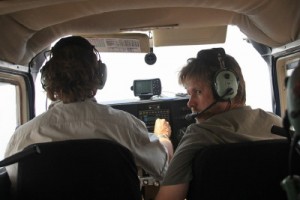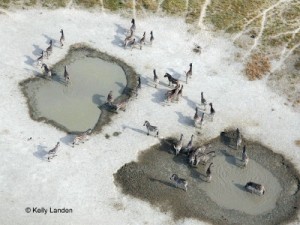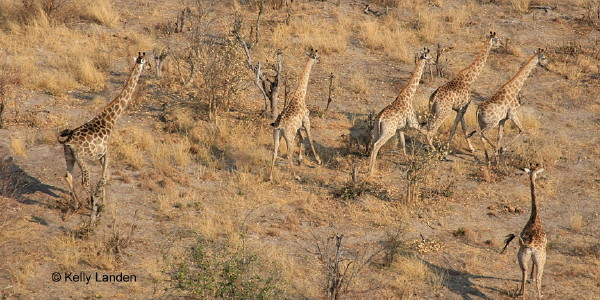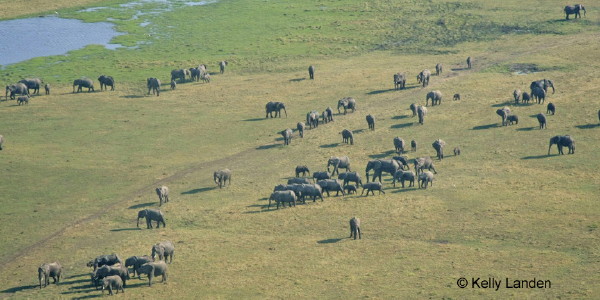EWB’s Aerial Survey of Mammoth Importance
We are very pleased to share with everyone what has kept Elephants Without Borders busy the last few months in the field. With the support of Botswana’s Dept. of Wildlife & National Parks and the San Diego Zoo’s Institute for Conservation Research, we finally just completed flying a mammoth aerial survey, counting elephants and wildlife species throughout northern Botswana. Piloted by Mr. Mike Holding, our 4 member survey team flew the last 3 months, approx. 250 hours, in a small, single-engine plane to complete the survey. The distance we covered was approximately 43,000 kilometers, flying along straight transect lines over Botswana’s varied terrain. That amount of flying is longer than the circumference of the Earth at the Equator! The study area essentially encompassed the entire elephant range in northern Botswana of approximately 115,800-km2. The boundaries extended across the southern extent of the Okavango Delta following the Southern Buffalo Fence, eastward to the Boteti River, the eastern boundary extended to the Zimbabwe border, then north to Kasane. The northern boundary followed along the Chobe, Linyanti and Kwando Rivers. Over high density wildlife areas, such the Okavango Delta, the sampling coverage was about 22%, the highest survey coverage ever flown over a vast area of northern Botswana, making this Botswana’s first aerial survey conducted with such a high sampling intensity.
This is important because the higher the sampling coverage, the more precise the population estimates. To learn more about aerial surveys, see www.elephantswithoutborders.org/surveys.php.
Wildlife species we counted included large and small herbivores, such as: Elephants, roan, sable, zebra, giraffe, eland, kudu, impala, lechwe, springbok, buffalo, wildebeest, hartebeest, tsessebe, waterbuck, warthog, and hippos; predators were also noted when seen. Other observations we recorded included: types of elephant herds (bull or family groups), elephant carcasses, elephant bones and if possible whether tusks were intact or missing. We also recorded observations of selected large birds and nesting sites. The birds counted included: critically endangered wattled crane, lappet-faced vultures, ground hornbill, ostrich, saddle-bill storks, fish eagles, and bateleurs.
Due to the growing concern on what possible impacts elephants are having on large trees in Botswana and considering Baobabs are an iconic tree in the country, we also counted Baobab trees and took note of their, size and possible damage they may have. We made additional notes on environmental conditions, such as the extent of bush fires and the structural integrity of Botswana’s veterinary fence lines and whether livestock or wildlife had crossed them.
The information on elephant and wildlife numbers, distribution, movements, and demographic characteristics from this study will be incorporated into population models to better understand a variety of research and management questions relating to wildlife ecology and conservation management in Botswana. Other management issues where this study will contribute important information to transboundary co-operation that could make a substantial and significant difference in conservation include: Illegal hunting, veterinary control measures, liase on hunting quotas and population monitoring. The results of this project will also help promote conservation efforts that seek to ultimately enhance economic opportunities for rural communities in the region.
EWB plans to publicize the results of this important aerial survey at an official launch of the report early in the upcoming year. In addition, we plan to give several presentations on the project results to key stakeholders. The primary objectives of these presentations and meetings will be to share information obtained from this study and from the on-going research activities of EWB, identify priority areas for wildlife corridors and develop strategies for promoting wildlife conservation in the region. We hope that the results of this collaborative survey with the DWNP will have fundamental conservation management implications for land-use planning and conservation efforts in Botswana.
We sincerely appreciate the logistic support in helping us accomplish this major task. Trumpets for Allen Bekker, Richard Uren, Adrian Dandrige and Felix Gosher. And, Thank you to Madeleine Delman Cohen and Jerry Cohen for your generous donation!
To learn more about Elephants Without Borders activities, log on to www.elephantswithoutborders.org
To help support EWB’s projects, donations can be received on www.elephantswithoutborders.org/donations.php
Tags: aerial survey count, africa, botswana, chobe, conservation, elephants, fire, Makgadikgadi, Okavango delta, research, Savuti, wildlife












